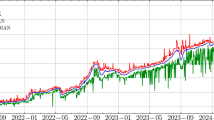Abstract
Several countries face the choice between targeting inflation independently and entering a monetary union that targets inflation. The present paper extends the theory of optimum currency areas to deal with this choice. In contrast to the conventional theory, countries might form more of an optimum currency area the more asymmetric supply shocks are.
Similar content being viewed by others
References
Ball, Laurence (1998) “Policy Rules for Open Economies.” In John B. Taylor (ed.), Monetary Policy Rules. Chicago: Chicago University Press.
Batini, Nicoletta and Andrew G. Haldane (1998) “Forward-Looking Rules for Monetary Policy.” NBER Working Paper No. 6543.
Bayomi, Tamim and Barry Eichengreen (1993) “Shocking Aspects of European Monetary Integration.” In Francisco Torres and Francesco Giavazzi (eds.), Adjustment and Growth in the European Monetary Union. Cambridge: Cambridge University Press.
Bean, Charles (1983) “Targeting Nominal Income: An Appraisal.” Economic Journal 93:806–819.
Berger Helge, Henrik Jensen, and Guttorm Schelderup (2001) “To Peg or Not to Peg? A Simple Model of Exchange Rate Regime Choice in Small Economies.” Economics Letters 73:161–167.
Blanchard, Olivier (1997) Macroeconomics. London: Prentice Hall.
Burgess, Simon M. (1988) “Employment Adjustment in UK Manufacturing.” Economic Journal 98:81–103.
Canzoneri, Matthew B. and Dale W. Henderson (1988) “Is Sovereign Policymaking Bad?” Carnegie-Rochester Conference Series 28:93–140.
—— (1991) Monetary Policy in Interdependent Economies: A Game Theoretic Approach. Cambridge: MIT Press.
Canzoneri, Matthew B., Charles Nolan, and Anthony Yates (1997) “Mechanisms for Achieving Monetary Stability: Inflation Targeting vs the ERM.” Journal of Money, Credit, and Banking 29:46–60.
Cecchetti, Stephen G. and Michael Ehrmann (1999) “Does Inflation Targeting Increase Output Volatility? An International Comparison of Policymakers' Preferences and Outcomes.” NBER Working Paper No. 7426.
Clarida, Richard, Jordi Galí and Mark Gertler (2001) “Optimal Monetary Policy in Open Versus Closed Economies: An Integrated Approach.” American Economic Review Papers and Proceedings 91:248–252.
Cooper, Richard N. (1985) “Economic Interdependence and Coordination of Economic Policies.” In Ronald W. Jones and Peter B. Kenen (eds.), Handbook of International Economics. Amsterdam: North-Holland.
De Grauwe, Paul (1994) The Economics of Monetary Integration (2nd revised edition). Oxford: Oxford University Press.
Frankel, Jeffrey A. and Menzie D. Chinn (1995) “The Stabilizing Properties of a Nominal GNP Rule.” Journal of Money, Credit, and Banking 27:318–334.
Frankel, Jeffrey A. and Andrew K. Rose (1996) “The Endogeneity of the Optimum Currency Area Criteria.” CEPR Discussion Paper No. 1473.
—— (1997) “Is EMU More Justifiable Ex Post Than Ex Ante?” European Economic Review 41:753–760.
Galí, Jordi and Tomasso Monacelli (2000) “Optimal Monetary Policy and Exchange Rate Volatility in a Small Open Economy.” Mimeo, Universitat Pompeu Fabra, Barcelona, Spain.
Genberg, Hans (1989) “Exchange Rate Management and Macroeconomic Policy: A National Perspective.” Scandinavian Journal of Economics 91:439–469.
King, Mervyn (1997) “Changes in UK Monetary Policy: Rules and Discretion in Practice.” Journal of Monetary Economics 39:81–97.
Krugman, Paul (1993) “Lessons of Massachusetts for EMU.” In Francisco Torres and Francesco Giavazzi (eds.), Adjustment and Growth in the European Monetary Union. Cambridge: Cambridge University Press.
Lane, Philip R. (1996) “Stabilization Policy in a Currency Union.” Economics Letters 53:53–60.
—— (2000) “Asymmetric Shocks and Monetary Policy in a Currency Union.” Scandinavian Journal of Economics 102:585–604.
Leitemo, Kai and Øistein Røisland (2003) “The Choice of Monetary Policy Regime for Small Open Economies.” Annales de Economie et de Statistique, forthcoming.
Meyer, Laurence H. (2001) “Inflation Targets and Inflation Targeting.” BIS Review 65:1–14.
Mundell, Robert (1961) “A Theory of Optimum Currency Areas.” American Economic Review 51:657–665.
Persson, Torsten and Guido Tabellini (1995) “Doubled-Edged Incentives: Institutions and Policy Coordination.” In Gene Grossman and Kenneth Rogoff (eds.), Handbook of International Economics, Vol III. Amsterdam: North Holland.
—— (1996) “Monetary Cohabitation in Europe.” NBER Working Paper No. 5532.
Rødseth, Asbjørn (1996) “Exchange Rate Versus Price Level Targets and Output Stability.” Scandinavian Journal of Economics 98:559–577.
Svensson, Lars E.O. (1997) “Optimal Inflation Targets, 'Conservative' Central Banks, and Linear Inflation Contracts.” American Economic Review 87:98–114.
—— (2000) “Open Economy Inflation Targeting.” Journal of International Economics 50:155–183.
Author information
Authors and Affiliations
Rights and permissions
About this article
Cite this article
RØisland, Ø., Torvik, R. Optimum Currency Areas Under Inflation Targeting. Open Economies Review 14, 99–118 (2003). https://doi.org/10.1023/A:1022331412107
Issue Date:
DOI: https://doi.org/10.1023/A:1022331412107




